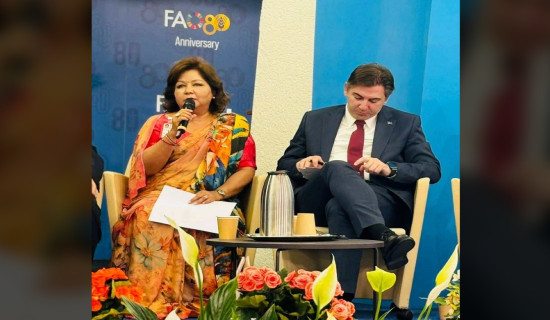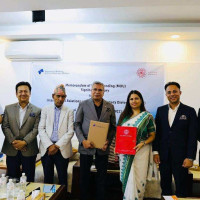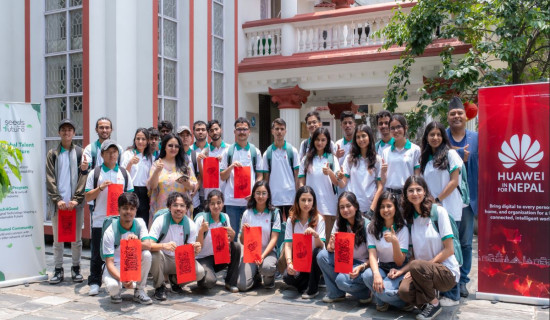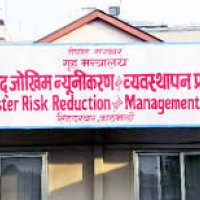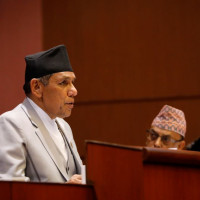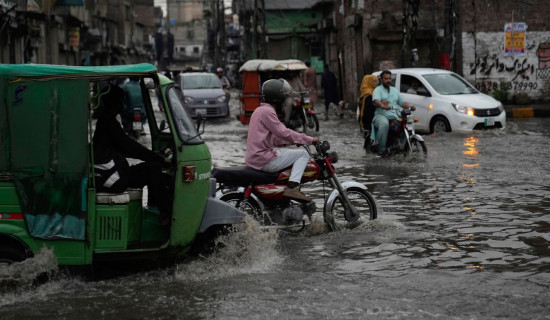- Wednesday, 2 July 2025
Dying of Yala glacier marked with ritual tributes
By A Staff Reporter,Kathmandu, May 13: Locals of Langtang and glaciologists from four glaciated countries in the Hindu Kush Himalayas (HKH) gathered to mark the accelerating disappearance of Nepal’s Yala Glacier in Langtang on Monday.
Yala, which has shrunk by 66 per cent and retreated 784 metres since it was first measured in the 1970s is projected to be among the first Nepali glaciers to join the growing numbers of glaciers declared ‘dead’ worldwide.
Over 50 people, including Buddhist monks and members of local community and glacier experts from Bhutan, China, India and Nepal completed the high-altitude trek to attend the “poignant” tribute event on Monday, which featured a Buddhist ceremony, speeches and the unveiling of two granite memorial plaques which will sit at the foot where the glacier stands today, said a press statement issued by the International Centre for Integrated Mountain Development (ICIMOD) on Monday.
Yala is notable not just for its rapid retreat, but also, thanks to its proximity to Kathmandu relative to other glacierised areas, for the central role it has played in advancing cryosphere research in a region that is known for lacking research capacity, the statement read.
Circa 100 people, including Afghan, Chinese, Indian, Nepali and Pakistani nationals, have been trained as glaciologists on Yala since ICIMOD started running training field visits to the site in 2011 and the glacier has served as a research site for 50 years.
Despite their importance in the provision of water for river flow on which billions of people rely and the fact that mountains in the region hold the largest mass of ice and snowpack outside the two geographic polar regions, glaciers in the Hindu Kush Himalayas are hugely understudied, it said.
According to the statement, Yala is one of just seven glaciers in the entire 3,500km-long arc of the Hindu Kush Himalayas to have been monitored annually for a decade or more and it is one of 38 glaciers with in-situ measurements, providing crucial data on the speed and extent of losses.
Earth’s mountains have lost close to nine trillion tonnes of ice since records began in 1975, the equivalent of a 2.72-metre-thick block of ice the size India. On current melt rates, many glaciers worldwide will not survive the 21st century.
The stones left at the base of the glacier carry messages by two world-famous authors --Manjushree Thapa and Andri Snaer Magnason, in English, Nepali and locally spoken Tibetan. Both authors have also backed ICIMOD’s #SaveOurSnow campaign and asked for their author fees to be donated to local climate action.
Thapa’s inscription said, “Yala, where the gods dream high in the mountains, where the cold is divine. Dream of life in rock, sediment and snow, in the pulverising of ice and earth, in meltwater pools the colour of sky. Dream. Dream of a glacier and the civilisation’s downstream. Entire ecosystems: our own sustenance. The cosmos. And all that we know and all that we love.”
Magnason’s inscription reads, “A message to the future: Yala glacier is one of 54,000 glaciers in HKH, most of which are expected to vanish this century due to global warming. This monument is to acknowledge that we know what is happening and what needs to be done. Only you know if we did it. May 2025 426ppm CO2 [parts per million of carbon dioxide in the atmosphere].”
Yala is the first glacier in Asia and the third glacier worldwide to carry a version of these words by Magnason. Plaques bearing his message also sit at the site of the world’s first glacier funeral, which took place in Magnason’s native Iceland in 2019, for OK Glacier, and at the site of the funeral for Ayoloco glacier in Mexico in 2021.
Funerals have also been held for the Swiss Pizol glacier in 2019, Clark glacier in Oregon in 2020 and Basodino glacier in Switzerland in 2021.
The tribute to Yala was organised by ICIMOD, working with local authority partners, including Gosaikunda Rural Municipality Ward No 4.
“Yala’s accelerating disappearance is totemic of the disastrous deglaciation and loss of snowpack we’re now seeing unfold across Earth’s mountains at a pace that far outstrips scientists’ worst-case scenarios,” said Pema Gyamtsho, Director General ICIMOD.
Shyam Saran, former foreign secretary and special envoy for and chief negotiator on climate change for India, who is attending the government’s Sagarmatha Sambaad event this week said, “I have trekked the mountains of the Himalayas for decades. The pace and scale of the deglaciation and loss of snowpack happening now, and which I have seen with my own eyes, is truly breathtaking.”
“While this thawing is currently upping the water available for Asia’s major economies and huge urban centres, we know this water is set to decline from mid-century, just 25 years from now. This has major implications for this region,” he said
ICIMOD’s glacier monitoring is supported by the Government of Norway and the Swiss Agency for Development and Cooperation.
Sharad Prasad Joshi, a Cryosphere Analyst at ICIMOD and Nepal’s national correspondent for the World Glacier Monitoring Service (WGMS) said the tribute event would be the fourteenth year and the twenty-sixth time that Joshi has visited Yala.



